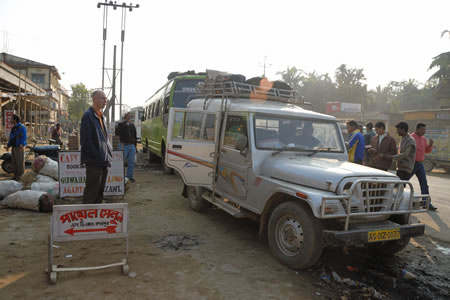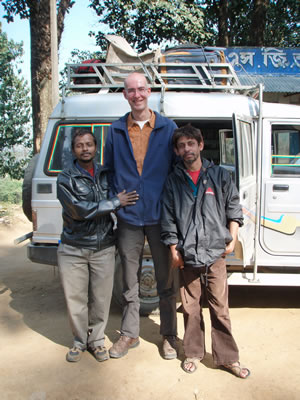

| In a military convoy to Agartala | |
Agartala (India), February 4th 2008 |
|
Our alarm clock wakes us at 04.45 in the morning. We have a long and tiring travel day ahead. Today we want to travel from the city of Silchar (in the state of Assam) to the city of Agartala (in the state of Tripura). The distance between the two cities is not really big. It is only 290 kilometres, but it seems that it will take more than eleven hours, because parts of the road need to be travelled in a military convoy. The state of Tripura still has some areas where militant separatists are fighting for more autonomy. The Indian government did not manage yet the resolve the insurgency in this area. The number of attacks that occur on this road is low, but attacks do happen. For this reason, travellers are only allowed to travel this road in military convoy. We have the choice to travel this stretch by bus or by sumo. The bus is some rupees cheaper than the sumo, but the sumo has the advantage being faster (at least that is what they say). The sumo (named after the Tata Sumo jeep), is a jeep that is shared by ten passengers. Two passengers are sitting besides the driver, and the two benches in the back are occupied by four passengers each. For short distances, the sumo is fine. But for longer distances, the bus is probably more comfortable because of its better leg space. We never did a long trip with a sumo before, but decided to try the sumo for this stretch. Just in hope to reach Agartala before darkness. |
|
 |
|
Waiting in a small town near Silchar for more passengers |
|
The sumo picks us up at 05.45 am. We are the first passengers, but at several places in Silchar, other passengers are picked up. Both the driver and the passengers hope that all ten seats are occupied. If the driver did not manage to sell all the seats, he will not leave. It is too costly for him to drive the long stretch to Agartala without having sold all the seats. Everybody understands that, so none of the passengers is pushing the driver to leave for Agartala with empty seats. When we leave Silchar, we still have four empty seats. That means that the driver will try to pickup new passengers along the way. This means that he drives very slowly through the villages in the hope that people also want to travel to Agartala. Just outside Silchar we stop at a busy road junction and this is the place where we have to wait till all seats are occupied. After an hour waiting, all seats are sold. The real trip to Agartala can start. The first part between Silchar and Agartala is flat and green. People are working on the land and water buffalo’s are lying in the mud and looking around satisfied. The local government has put signs with aphorisms along the road, to convince drivers to drive safely. As a passenger it is nice to read the aphorisms, but we do not think that it affects the drivers, just for the reason that the aphorisms are in English, a language that is not often spoken in this part of India. Our three favourite aphorisms of the day are: “With Whiskey, I am Risky”, “Speed thrills, but kills” and “Life is short, don’t make it shorter”. It is not a bad idea of the government to ask for more attention for the safety on the roads. Indian people are in general driving like idiots and there is only one rule: “the right of the strongest”. This means that the pedestrians give way to bicycle rickshaws, bicycle rickshaws give way for auto-rickshaws, auto-rickshaws give way to cars and cars give way to buses and trucks. Buses and trucks are the kings of the road and the only thing they stop for is a (holy) cow. Travelling by road is dangerous in India and for that reason, many drivers are looking for support at one of the gods. Once in a while, our jeep slows down (without stopping) and the driver opens his windows. He, and some of the passengers, take some coins out of their wallet and throw it to a temple that we pass. The gods are well-disposed, so we can increase the speed again. In one of the villages that we pass, we have to wait for a passing train. The total waiting time is 45 minutes! This is not because it took so long for the train to pass, but because of the traffic chaos that occurred afterwards. While the train passes, road users are using both lanes at both sides of the railway track in the hope to pass some vehicles. The result is that the traffic is completely jammed till long after the train left. During these 45 minutes, we were “terrorized” by a beggar (a young girl) who saw some white faces in the sumo. She walked for more than 15 minutes around our jeep, knocking at the windows to try to get some money from us. Even after the driver threatened her to give her a box on the ear, she still didn’t go. It is a pity that this girl is not able to show her perseverance at school. While many parents keep their children away from school because they can not afford it, others prefer the short-term money that a child can earn as beggar. |
|
 |
|
Edwin and the sumo driver (left) and another passenger |
|
| At around noon we stop for a lunch break. Our driver is very proud to have two foreigners in his car. He is especially proud of Edwin, because he is the tallest person he has ever seen. During the break, the driver walks around excited, to tell everybody that the two foreigners are travelling in his jeep. He also leads us to one the rest rooms (with beds) in the wrong assumption that we needed a rest after six hours travelling. However, we preferred to take a rest in the sun outside, because the weather was really great. We were wondering if we really had to travel in military convoy, because we didn’t see one so far. One of the fellow travellers explained to us that the first convoy starts in the small town of Manu at 02.00 pm. There are only three military convoys per day, two in the morning and one in the afternoon. If you miss the last convoy, you have to wait till the following day because it is not allowed to travel the road individually. The first military convoy takes approximately one hour. Then we can drive independently again for half an hour after which we have to join a second convoy at 04.00 pm.
When we arrived in Manu, there are already some cars waiting for the convoy. Everybody parks his car along the side of the road and stretched their legs. Local sellers try to earn some money by selling tea, fresh fruit and potato chips. The military people are in front and block the road to prevent that cars try to sneak away. At the moment that the military people blow their horns to announce the start of the convoy, everybody jumps back in the car again to be sure that they do not miss the last convoy. The convoy starts driving and after every ten to fifteen cars, a military jeep with heavily armed soldiers from the Tripura State Riffles joins the convoy. It is a sturdy name for sturdy looking military people. The soldiers wear black fabrics around their head to prevent breathing too much dust. While driving in the convoy, and passing small settlements, we saw once in a while also military people along the road. It is strange to see little kids playing in a village with self-made toys, while heavily armed soldiers are guarding the road only a couple of metres away. After the first military convoy, everybody is “free” again. It is also the moment that the battle of the road starts again. Also our driver tries to improve his position before we arrive at the second convoy. Doing this is madness because the buses and trucks are required to drive in front of the convoy. So, every bus or truck that we pass now by risking our lives in these hilly areas, will pass us before the second convoy starts. But that is something our driver does not want to hear. At 03.45 pm we arrive at the point where the second convoy. The second convoy started at 04.00 pm and was like the first convoy. We were again amazed to see that all the villages that we passed seemed to be so peaceful. It is hard to understand that this area can be so violent. Again, the convoy is very slow and once in a while we have to stop for several minutes. The speed of the convoy is determined by the slowest vehicle, and that are definitely the trucks that drive in front. It is already dark when we leave the second convoy and “only” sixty kilometres remain. Again, our driver knows to find the gas pedal and tries to pass as much vehicles as possible before we reach Agartala. This is the last chance for the sumo’s to prove that they are faster than the bus. In our opinion, the bus is much more comfortable than the sumo, especially on these long stretches. However, the enthusiasm and company of our driver and fellow passengers compensated a lot for the uncomfortable seats in the sumo. © copyright - Babakoto.eu / 2008 |
|